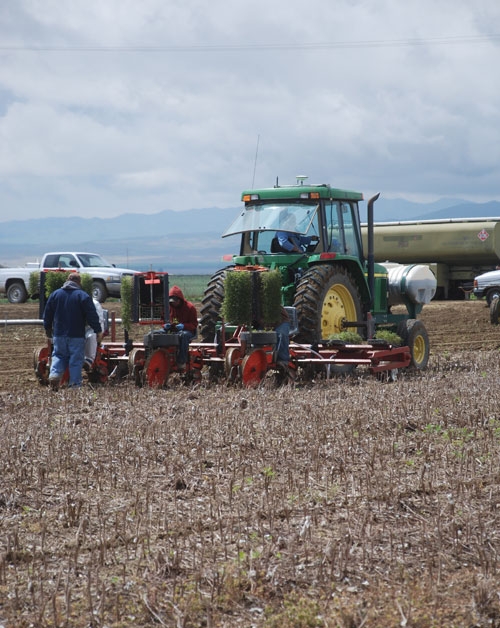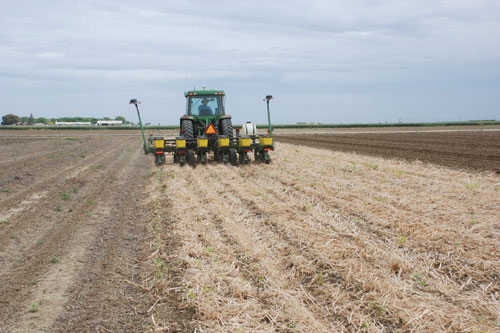
Posts Tagged: tillage
Deep tillage and cover crops for Palmer amaranth control
Glyphosate-resistant (GR) Palmer amaranth is, currently, the most significant weedy pest of cotton...
Watching out for native worker bees
With warm weather and mostly dry skies, some California farmers are prepping their fields for spring planting. On many fields used to grow squash and pumpkins, native squash bees (Peponapis pruinosa), valuable pollinators for squash growers, are nesting in the soil, waiting for spring emergence. With over ten thousand acres of squash and pumpkins grown in California in 2011, the success of pollination covers a lot of ground.

For native bee researcher Katharina Ullmann, understanding how these bees will be impacted by the upcoming tillage and other farming practices are big questions that can help farmers make decisions that protect native bee populations in their fields and maximize the benefit farmers see from pollinators. Ullmann was recently awarded a grant from Western SARE (Sustainable Agriculture Research and Education) and the National Science Foundation to fund her doctoral research on how crop rotations and tillage practices affect native squash bee populations.

Native squash bees nest 5 to 20 inches deep in the soil, and plowing or disking often disturbs soil as much as 20 inches deep, potentially damaging bee nests. Conservation tillage and no-till practices are increasingly seen as ways to lower fuel use and on-farm emissions from nitrogen and carbon dioxide, as well as decrease water runoff. Protecting native bee populations could potentially be an additional co-benefit to these methods.
I think about native bees as an insurance policy and potentially a yield increaser,” says Ullmann. “Honey bees are important; they’re always going to be important. But it can be beneficial for growers to know if they have crop-pollinating native bees flying around if, for example, honey bee prices spike or if it’s hard for a grower to get the number of honey bee colonies he or she needs.” Too, with new studies highlighting the productivity of native bees (in some cases doubling fruit set compared to honey bees), there is growing incentive to protect nesting grounds.
The results of Ullmann’s tillage study, in coordination with a parallel study on the effect of crop rotation on bee populations, will be turned into a user-friendly web tool for farmers to assess which combination of in-field practices will likely be best for fostering bee populations. “In creating these models of tillage and crop rotation practices, we’re hoping to help farmers find the synergy between different farming practices that yield the greatest benefits,” says Ullmann.
“Not all farmers will change tillage or crop rotation practices just because of bees, but maybe this is another piece of information that farmers can use to make informed management decisions. “Ultimately,” says Ullmann, “my goal is to provide farmers with that opportunity.”
Looking for squash bees on your farm or in your garden? They look similar to honey bees but with fuzzier legs that lift dry pollen from squash blossoms, and male bees have a yellow spot on their face that resembles a nose. But perhaps the easiest way to identify them — gently squeeze a closed squash blossom and wait to hear a buzz. The bee inside is likely a native squash bee, resting up in preparation for more work.
Weed control strategies and yield response in a pepper crop (Capsicum annuum L.) mulched with hairy vetch (Vicia villosa Roth.) and oat (Avena sativa L.) residues
Abstract: Organic mulches could be a part of a wide strategy of integrated weed management in...
Record no-till yields achieved in 2011

“The bar has been set,” said UC Cooperative Extension vegetable crops specialist Jeff Mitchell. “After toiling for more than a decade, we’ve finally succeeded in putting the pieces together this past season.”
Researchers harvested 3.4 bales per acre of cotton and 53 tons per acre of processing tomatoes using no-till techniques. Plots managed with conventional tillage practices averaged about 3.4 bales per acre for cotton and 49 tons per acre for tomatoes.
The research was conducted at the UC West Side Research and Extension Center near Five Points, Calif. Scientists established the cotton crop by direct seeding into beds that had not been touched since the preceding tomato crop, except by two herbicide sprays. The 2011 tomato crop was established with a no-till transplanter following the 2010 cotton crop, which had only been shredded and root-pulled under a waiver granted by CDFA’s Pink Bollworm Eradication Program.
The 2011 regime represented the first time since the start of the study in 1999 that the Five Points research team strictly followed no-tillage techniques for both crops. In past years, in which tomato yields reached the mid-60 tons per acre, in-season cultivation for weed control was used. In 2011, however, the goal of going completely no-till was realized in preparation for 2012, when the field will be converted to subsurface drip irrigation for all subsequent no-till plantings. Scientists believe the 2011 tomato harvest for both conventional and no-till plots was lower than in previous years because planting took place April 7 due to weather and scheduling delays.
UC Cooperative Extension agricultural economist Karen Klonsky estimates that switching to no-till production reduced expenditures by about $135 per acre for the tomato crop and about $40 per acre for cotton.

Future goals for conservation tillage production systems include profitability, resource quality, conservation, as well as broader ecosystem services.
“No-till makes sense as a means for lowering production costs and cutting dust and greenhouse gas emissions,” Mitchell said. “No-till also improves soil functions, such as increased carbon storage, greater stability of soil aggregates, increased porosity and water infiltration, and a larger population of earthworms.”
The benefits of no-till farming have been recognized by researchers and farmers in other regions, such as the Great Plains and the Pacific Northwest regions of the U.S., across much of Canada, and also throughout large areas of South America.
“These benefits start to pile up pretty fast once longer-term and broader sustainability goals are factored in,” Mitchell said.
Mitchell and his Five Points team are part of California’s Conservation Agriculture Systems Institute (CASI), a diverse group of more than 1,500 farmers, industry representatives, university, Natural Resource Conservation Service and other public agency members. Over the past 10 years, the team has come together to develop information on the true costs and benefits of the production system and irrigation management alternatives and to help develop appropriate sustainability goals for the long haul. For more information on the body of CT research, see the UC Conservation Tillage website.
“One of the things that CASI does is track changes in tillage management practices that are used throughout the San Joaquin Valley,” said long-time member and former air quality coordinator for the California Association of Resource Conservation Districts Ron Harben. “Our most recent survey for 2010 showed an increase of about 5 percent in no-till and strip-till acreage over previous years. As of 2010, over 47 percent of the cropland in the San Joaquin Valley is using some form of conservation tillage.”
Congressman praises UC research and extension
United States Congressman Jim Costa visited the UC West Side Research and Extension Center in Five Points last week to introduce his new legislative director, Nick Choate, to west side farming practices. A focus of the visit was conservation tillage, a farming system in which growers minimize tractor work and plant crops in the residue of a previous crop.
UC research has shown that CT practices have numerous benefits, including water conservation, dust suppression, reduced runoff, lower labor needs and costs, fuel savings and carbon sequestration. Members of the Conservation Tillage and Cropping Systems workgroup asked Costa for federal funding to study the adoption process and fund CT extension activities.
Costa is a member of the House Committee on Agriculture, which is laying the groundwork for the reauthorization of the Farm Bill in 2012.
He shared the following comments about the value of UC Agriculture and Natural Resources programs:
